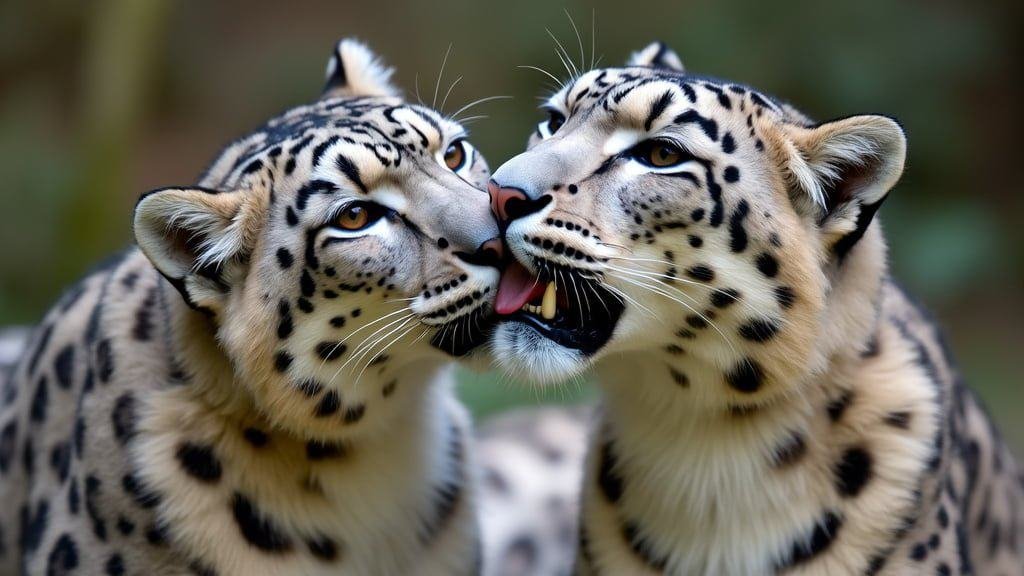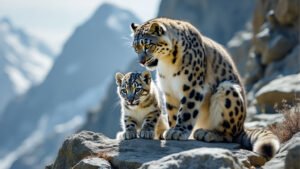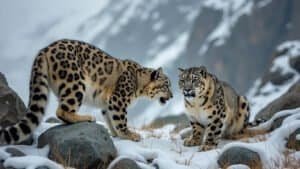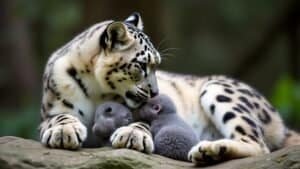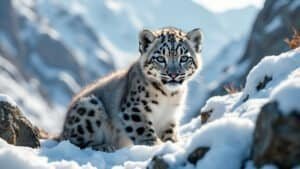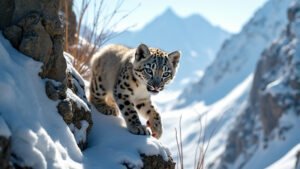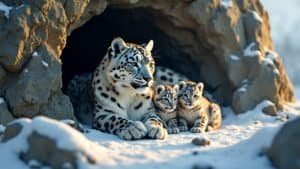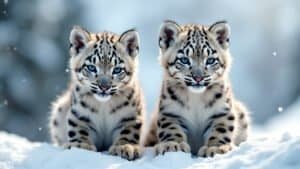Introduction
Snow leopards, elusive and majestic creatures of the high mountains, exhibit a fascinating array of courtship behaviors. Understanding these behaviors is crucial for conservation efforts and for gaining insights into their mysterious lives
This article delves into how snow leopards communicate during courtship, including vocalizations, scent marking, and body language. It also explores the criteria for mate selection, the challenges faced during courtship, and compares these behaviors with those of other big cats. By uncovering these intricate patterns, we can better appreciate and protect these magnificent animals
Communication During Snow Leopard Courtship
Communication plays a pivotal role in the courtship rituals of snow leopards, facilitating the intricate dance of attraction and mate selection
These solitary animals rely on a combination of vocalizations, scent marking, and body language to convey their intentions and establish bonds. Understanding these communication methods provides valuable insight into their mating behaviors and social interactions
Vocalizations and Their Significance
Snow leopards are known for their vocal range, which includes a variety of sounds used during courtship. These vocalizations serve multiple purposes, from attracting potential mates to warding off rivals
One of the most notable calls is the “chuffing” sound, a non-aggressive vocalization often used during close encounters between males and females. This sound, characterized by a series of low-intensity exhalations, indicates a friendly approach and is crucial in initiating contact
Moreover, snow leopards use long-distance calls, akin to roars, to announce their presence and attract mates from afar. These calls can travel across vast mountainous terrains, helping individuals locate each other despite their solitary nature and expansive territories
According to a study by McCarthy et al. (2005), these vocalizations are particularly common during the breeding season, underscoring their importance in reproductive communication
Scent Marking and Territory
Scent marking is another essential component of snow leopard courtship behavior. These felines have scent glands located on their cheeks, paws, and at the base of their tails, which they use to leave chemical signals. By rubbing their bodies against rocks and vegetation, they deposit pheromones that convey information about their reproductive status, territorial boundaries, and identity
Male snow leopards are especially active in scent marking during the mating season. This behavior not only attracts females but also signals to other males that a particular territory is occupied
Research by Smith et al. (1990) highlighted that the frequency and intensity of scent marking increase during courtship, suggesting its critical role in mating success. Females, on the other hand, respond to these scent marks, often leading them to the males
Body Language and Physical Displays
Physical displays and body language complement vocalizations and scent marking in snow leopard courtship. These visual cues are vital in non-verbal communication and help establish mutual interest and readiness to mate
Submissive postures, such as crouching and rolling on the ground, indicate a willingness to engage, while dominant displays, like standing tall and puffing out the fur, show confidence and readiness
During courtship, males often follow females closely, mimicking their movements and engaging in playful behaviors. This “shadowing” behavior helps in building trust and reducing aggression, which is essential given the solitary and territorial nature of snow leopards
Additionally, grooming and nuzzling are common, fostering a bond between potential mates
Mate Selection in Snow Leopards
Mate selection in snow leopards is a nuanced process influenced by various factors including physical traits, environmental conditions, and individual behaviors. These solitary predators, residing in the rugged mountains of Central and South Asia, engage in intricate rituals to choose suitable partners, ensuring the continuation of their species
This section explores the criteria snow leopards use for mate selection, the environmental influences that affect their choices, and the duration of the courtship period
Criteria for Choosing a Mate
Snow leopards, like many other big cats, are selective when it comes to choosing their mates. Females often assess potential mates based on several criteria, ensuring that only the fittest and most genetically compatible individuals are chosen
One primary criterion is physical health and strength, which can be observed through a male’s physical condition and display behaviors. Males with robust physiques, glossy coats, and evident vitality are more likely to be chosen, as these traits indicate good health and strong genetic makeup
Behavioral traits also play a crucial role in mate selection. Males that exhibit patience, gentleness, and adept courtship behaviors are favored. These behaviors include the aforementioned vocalizations, scent marking, and body language
The ability to successfully communicate and interact without aggression demonstrates a male’s suitability as a mate. Furthermore, a study by Johansson et al. (2015) revealed that females might also consider the territorial dominance of males, as those controlling prime territories often have better access to resources, enhancing their appeal
Environmental Influences
The harsh and variable environment in which snow leopards live significantly impacts their mating behaviors and mate selection. Factors such as prey availability, weather conditions, and geographic terrain play a crucial role in shaping these behaviors
In regions where prey is abundant, snow leopards are more likely to engage in prolonged courtship displays, as the energetic cost is lower. Conversely, in areas with scarce resources, courtship periods may be shorter and more competitive
Seasonal changes also influence mate selection. Snow leopards typically mate between January and March, when environmental conditions are most favorable for rearing cubs. The timing ensures that cubs are born during the warmer months when food is more abundant, increasing their chances of survival
According to research by McCarthy and Chapron (2003), climate and seasonal variations can cause fluctuations in courtship behaviors, with some years showing more intense and extended courtship periods compared to others
Duration of Courtship Period
The courtship period of snow leopards is relatively brief, lasting anywhere from a few days to a few weeks. During this time, both males and females engage in repeated interactions that strengthen their bond and prepare them for mating
The duration of this period is influenced by the aforementioned environmental factors and the readiness of the female to mate
Females exhibit signs of estrus, such as increased vocalizations and scent marking, signaling their receptiveness to males. Once a pair has formed, they will spend several days together, engaging in behaviors such as mutual grooming, play-fighting, and close following
These activities not only reinforce their bond but also ensure that the female is in peak condition for conception. Studies by Kachel et al. (2017) indicate that the success of mating is closely linked to the duration and quality of the courtship period, highlighting its importance in snow leopard reproduction
Challenges in Snow Leopard Courtship
Snow leopards face numerous challenges during courtship, ranging from environmental obstacles to human encroachment. These challenges significantly impact their ability to find and select mates, ultimately affecting their reproductive success and survival as a species
This section examines the geographic and environmental barriers, the effects of human activities, and the role of intraspecific competition in snow leopard courtship
Geographic and Environmental Barriers
The rugged and expansive terrain of the snow leopard’s habitat poses significant challenges for courtship
These big cats inhabit high-altitude regions of Central and South Asia, where steep cliffs, deep valleys, and vast distances separate individuals. Such geographical barriers can make it difficult for snow leopards to locate potential mates, especially since they are solitary animals with large territories
Moreover, harsh weather conditions, such as extreme cold, heavy snowfall, and blizzards, can further hinder their movement and ability to communicate over long distances. According to research by Janečka et al. (2011), these environmental factors can limit the frequency and duration of courtship interactions, reducing the chances of successful mating
Human Encroachment and Its Effects
Human activities have increasingly encroached upon snow leopard habitats, introducing new challenges for their courtship behaviors
Habitat fragmentation due to infrastructure development, mining, and agriculture disrupts the natural landscapes that snow leopards depend on. These activities not only reduce the available territory for snow leopards but also create physical barriers that impede their movement
Additionally, human presence and activity can lead to increased stress and disturbance for snow leopards. The presence of livestock and herders, as well as the risk of poaching, forces these cats to avoid certain areas, limiting their range for finding mates
A study by Chetri et al. (2017) highlighted that snow leopards in regions with high human activity exhibit altered behaviors and reduced reproductive success, emphasizing the impact of human encroachment on their natural courtship rituals
Intraspecific Competition
Competition among snow leopards for mates is another significant challenge during courtship. Males often compete fiercely for access to females, engaging in physical confrontations and displays of dominance. These interactions can result in injuries or even death, reducing the number of males available for mating and affecting the genetic diversity of the population
Intraspecific competition is intensified by the solitary nature of snow leopards and the large territories they maintain. With fewer opportunities to encounter potential mates, males must assert their dominance and secure prime territories to attract females
According to a study by Sharma et al. (2014), the success of a male in securing a mate is closely tied to his ability to dominate and defend a territory, highlighting the critical role of competition in snow leopard courtship
Furthermore, the limited number of females in certain regions can exacerbate competition among males. As females come into estrus only once a year and for a short period, the window for mating is narrow. This intensifies the competition and the need for males to be in peak physical condition and highly strategic in their courtship efforts
Comparison with Other Big Cats
Comparing the courtship behaviors of snow leopards with those of other big cats reveals both unique adaptations and commonalities. This examination provides deeper insights into the evolutionary traits and environmental adaptations that shape these behaviors across different species
In this section, we explore the similarities and differences in courtship behaviors among big cats, unique adaptations of snow leopards, and the evolutionary perspectives that underpin these behaviors
Similarities and Differences
While snow leopards share many courtship behaviors with other big cats, such as vocalizations, scent marking, and physical displays, there are notable differences driven by their unique habitats and lifestyles
For instance, lions, which live in social prides, exhibit different courtship behaviors compared to the solitary snow leopards. Lions engage in extended periods of courtship, often involving multiple males competing for a single female, with courtship rituals that include roaring, grooming, and mating multiple times over several days
In contrast, tigers, which are also solitary like snow leopards, show similarities in their use of scent marking and vocalizations to communicate with potential mates
However, tigers inhabit dense forests and grasslands, which influence their courtship behaviors differently than the high-altitude environments of snow leopards. Tigers often use vocalizations that can penetrate dense vegetation, whereas snow leopards rely more on scent marking due to the open and rocky terrains they inhabit
Leopards, another solitary big cat species, display courtship behaviors that closely resemble those of snow leopards. Both species use scent marking and physical displays such as rolling and grooming to attract mates. However, the primary difference lies in their habitats; leopards are found in diverse environments ranging from savannas to forests, affecting their specific courtship behaviors and strategies
Unique Adaptations
Snow leopards have evolved several unique adaptations to their harsh, high-altitude habitats that influence their courtship behaviors
One of the most distinctive adaptations is their thick fur and large, well-insulated nasal passages, which allow them to survive in cold environments. These physical traits are not directly related to courtship but play a role in their overall fitness and attractiveness to potential mates
Another unique adaptation is their ability to navigate steep and rocky terrains with ease, which is crucial during courtship chases and displays. Snow leopards’ powerful hind legs enable them to leap great distances, a trait that can be showcased during courtship to demonstrate strength and agility
Additionally, their large paws act as natural snowshoes, providing stability on snow and ice, further aiding in their courtship rituals
The solitary nature and vast territories of snow leopards also require them to develop strong scent-marking behaviors. Unlike big cats in more densely populated areas, snow leopards must communicate over greater distances. Their scent markings, which contain information about their reproductive status and territorial boundaries, are critical for attracting mates in these expansive and isolated regions
Evolutionary Perspective
The courtship behaviors of snow leopards and other big cats can be understood from an evolutionary perspective, highlighting how environmental pressures and social structures have shaped these behaviors over time
The solitary lifestyle of snow leopards is a result of the sparse distribution of prey in their high-altitude habitats. This has led to the development of behaviors that minimize direct confrontation and maximize reproductive success through efficient communication and display rituals
In contrast, social big cats like lions have evolved group living and cooperative behaviors to hunt large prey and defend territories. Their courtship behaviors reflect the need for strong social bonds and the ability to manage intra-group dynamics during the breeding season
Evolutionarily, these differences underscore the adaptability of big cats to their respective environments, shaping their courtship rituals to optimize reproductive success
Studies by Bailey (1993) and Sunquist and Sunquist (2002) on the evolutionary biology of big cats suggest that the diverse courtship behaviors observed today are the result of millions of years of adaptation to varying ecological niches
For snow leopards, their unique adaptations and solitary courtship strategies reflect the specific demands of surviving and reproducing in one of the most challenging environments on Earth
Conclusion
Snow leopards, with their elusive nature and unique adaptations, exhibit a fascinating array of courtship behaviors that ensure their survival in some of the harshest environments on Earth
From the intricate vocalizations and scent marking that facilitate long-distance communication to the physical displays and environmental challenges they overcome, these behaviors are essential for successful mating and species continuity. Comparing these behaviors with those of other big cats highlights both shared traits and distinctive adaptations shaped by their respective habitats
By understanding the courtship rituals of snow leopards, we gain deeper insights into their lives and the critical importance of preserving their natural habitats. Protecting these majestic creatures requires comprehensive conservation efforts that address the environmental and human-induced challenges they face, ensuring that future generations can witness the beauty and complexity of snow leopard courtship in the wild
